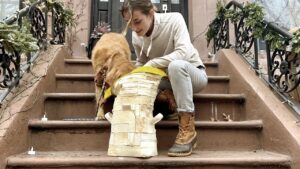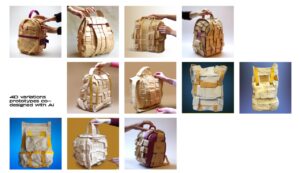
The Forager Fashion and Design (FFAD) program puts Forager’s mycelium materials in the hands of independent designers.
For designers, the introduction of a new kind of material is a rare event that creates new possibilities. Forager mycelium hides and foams represent just such a material, made on upcycled plants that would otherwise go to waste, creating high value, regenerative materials aligned with the cycles of nature. Forager is Ecovative’s division focused on premium mycelium alternatives for leather and foams in fashion, apparel, automotive, and other industries. FFAD launched to discover and democratize the possibilities of mycelium, by offering designers early access to the material, and a blank slate on which to create. These designs suggest the future of sustainable products made with mycelium materials.
The Project: Myco.ol
The Designer: Mary Lempres — Industrial Design at Pratt University

 Concept:
Concept:
The Myco.ol is a dry bag style cooler that can be carried or worn. The insulating properties of mycelium were applied to preserving food, a reversal of mycelium’s role as a decomposer in nature. Myco.ol also applies mycelium to the problem of short-term uses of insulative materials that don’t decompose, and accumulate in the environment. The patterning and patchwork was inspired in part by
Billie Eilish x Nike ‘Mushroom’ line of Air Force 1’s, and seeks to establish a unique form language for mycelium materials.
“It’s nice to show that it is made by nature, it’s not something that’s so industrialized where everything is exactly the same.”
Process:
Forager mycelium foam and leather is layered sewn to cotton backing, with the mycelium operating as insulation and impact barrier. Using AI to explore possible patterns, the strips of mycelium are arranged to facilitate movement and folding where appropriate, with more leather-like material towards the top, and more foam materials towards the bottom. The materials are dyed with turmeric and other natural dyes, sealed against moisture with bioresin, and the clasps are 3D printed with wood-based filaments, with the intention of creating a bag that is as compostable as possible.
“It opens up the doorway to other possibilities, and finding new fabrication and manufacturing processes for specific applications.”
 About the Designer:
About the Designer:
Mary Lempres is a graduate student of industrial design at Pratt University in Brooklyn, NY. As the manager of a student materials lab, with a special interest in regenerative materials formed through natural processes, Mary was drawn to Ecovative’s mycelium among several biodesign projects, including growing algae, casein, and bio-cement for artificial reefs. In addition to the materials and products themselves, Mary’s work is driven by an interest in making nature a collaborator in processes that will ultimately have an impact on nature, something she calls ‘nature co-design’.
 “I hope this is a sign that design is changing in a positive way. It’s really cool to participate with nature as a co-designer, to look at something that’s alive and have it play a dominant role in the influence of the design process”
Click here
“I hope this is a sign that design is changing in a positive way. It’s really cool to participate with nature as a co-designer, to look at something that’s alive and have it play a dominant role in the influence of the design process”
Click here to learn more about the FFAD program, and find out how to get first access to Forager™ Foams and Hides.
Want to get creating with mycelium materials now? Anyone can work with Ecovative’s MycoComposite™ materials, visit
Grow.Bio for all the tools and information you need.
 The Forager Fashion and Design (FFAD) program puts Forager’s mycelium materials in the hands of independent designers.
For designers, the introduction of a new kind of material is a rare event that creates new possibilities. Forager mycelium hides and foams represent just such a material, made on upcycled plants that would otherwise go to waste, creating high value, regenerative materials aligned with the cycles of nature. Forager is Ecovative’s division focused on premium mycelium alternatives for leather and foams in fashion, apparel, automotive, and other industries. FFAD launched to discover and democratize the possibilities of mycelium, by offering designers early access to the material, and a blank slate on which to create. These designs suggest the future of sustainable products made with mycelium materials.
The Project: Myco.ol
The Designer: Mary Lempres — Industrial Design at Pratt University
The Forager Fashion and Design (FFAD) program puts Forager’s mycelium materials in the hands of independent designers.
For designers, the introduction of a new kind of material is a rare event that creates new possibilities. Forager mycelium hides and foams represent just such a material, made on upcycled plants that would otherwise go to waste, creating high value, regenerative materials aligned with the cycles of nature. Forager is Ecovative’s division focused on premium mycelium alternatives for leather and foams in fashion, apparel, automotive, and other industries. FFAD launched to discover and democratize the possibilities of mycelium, by offering designers early access to the material, and a blank slate on which to create. These designs suggest the future of sustainable products made with mycelium materials.
The Project: Myco.ol
The Designer: Mary Lempres — Industrial Design at Pratt University

 Concept:
The Myco.ol is a dry bag style cooler that can be carried or worn. The insulating properties of mycelium were applied to preserving food, a reversal of mycelium’s role as a decomposer in nature. Myco.ol also applies mycelium to the problem of short-term uses of insulative materials that don’t decompose, and accumulate in the environment. The patterning and patchwork was inspired in part by Billie Eilish x Nike ‘Mushroom’ line of Air Force 1’s, and seeks to establish a unique form language for mycelium materials.
“It’s nice to show that it is made by nature, it’s not something that’s so industrialized where everything is exactly the same.”
Process:
Forager mycelium foam and leather is layered sewn to cotton backing, with the mycelium operating as insulation and impact barrier. Using AI to explore possible patterns, the strips of mycelium are arranged to facilitate movement and folding where appropriate, with more leather-like material towards the top, and more foam materials towards the bottom. The materials are dyed with turmeric and other natural dyes, sealed against moisture with bioresin, and the clasps are 3D printed with wood-based filaments, with the intention of creating a bag that is as compostable as possible.
“It opens up the doorway to other possibilities, and finding new fabrication and manufacturing processes for specific applications.”
Concept:
The Myco.ol is a dry bag style cooler that can be carried or worn. The insulating properties of mycelium were applied to preserving food, a reversal of mycelium’s role as a decomposer in nature. Myco.ol also applies mycelium to the problem of short-term uses of insulative materials that don’t decompose, and accumulate in the environment. The patterning and patchwork was inspired in part by Billie Eilish x Nike ‘Mushroom’ line of Air Force 1’s, and seeks to establish a unique form language for mycelium materials.
“It’s nice to show that it is made by nature, it’s not something that’s so industrialized where everything is exactly the same.”
Process:
Forager mycelium foam and leather is layered sewn to cotton backing, with the mycelium operating as insulation and impact barrier. Using AI to explore possible patterns, the strips of mycelium are arranged to facilitate movement and folding where appropriate, with more leather-like material towards the top, and more foam materials towards the bottom. The materials are dyed with turmeric and other natural dyes, sealed against moisture with bioresin, and the clasps are 3D printed with wood-based filaments, with the intention of creating a bag that is as compostable as possible.
“It opens up the doorway to other possibilities, and finding new fabrication and manufacturing processes for specific applications.”
 About the Designer:
Mary Lempres is a graduate student of industrial design at Pratt University in Brooklyn, NY. As the manager of a student materials lab, with a special interest in regenerative materials formed through natural processes, Mary was drawn to Ecovative’s mycelium among several biodesign projects, including growing algae, casein, and bio-cement for artificial reefs. In addition to the materials and products themselves, Mary’s work is driven by an interest in making nature a collaborator in processes that will ultimately have an impact on nature, something she calls ‘nature co-design’.
About the Designer:
Mary Lempres is a graduate student of industrial design at Pratt University in Brooklyn, NY. As the manager of a student materials lab, with a special interest in regenerative materials formed through natural processes, Mary was drawn to Ecovative’s mycelium among several biodesign projects, including growing algae, casein, and bio-cement for artificial reefs. In addition to the materials and products themselves, Mary’s work is driven by an interest in making nature a collaborator in processes that will ultimately have an impact on nature, something she calls ‘nature co-design’.
 “I hope this is a sign that design is changing in a positive way. It’s really cool to participate with nature as a co-designer, to look at something that’s alive and have it play a dominant role in the influence of the design process”
Click here to learn more about the FFAD program, and find out how to get first access to Forager™ Foams and Hides.
Want to get creating with mycelium materials now? Anyone can work with Ecovative’s MycoComposite™ materials, visit Grow.Bio for all the tools and information you need.
“I hope this is a sign that design is changing in a positive way. It’s really cool to participate with nature as a co-designer, to look at something that’s alive and have it play a dominant role in the influence of the design process”
Click here to learn more about the FFAD program, and find out how to get first access to Forager™ Foams and Hides.
Want to get creating with mycelium materials now? Anyone can work with Ecovative’s MycoComposite™ materials, visit Grow.Bio for all the tools and information you need. 












